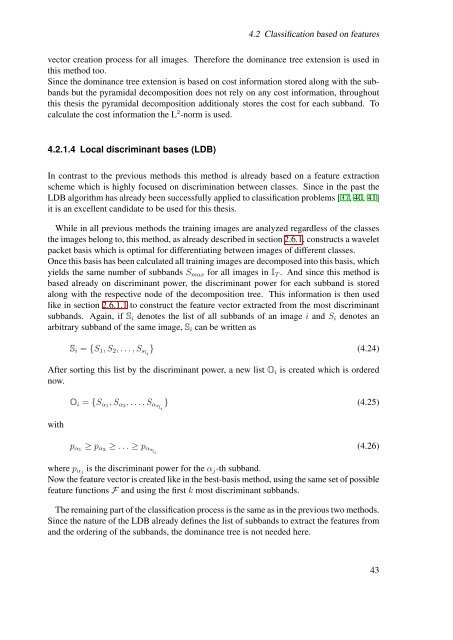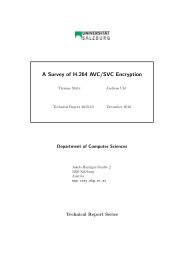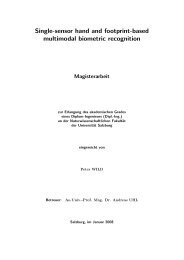Pit Pattern Classification in Colonoscopy using Wavelets - WaveLab
Pit Pattern Classification in Colonoscopy using Wavelets - WaveLab
Pit Pattern Classification in Colonoscopy using Wavelets - WaveLab
Create successful ePaper yourself
Turn your PDF publications into a flip-book with our unique Google optimized e-Paper software.
4.2 <strong>Classification</strong> based on features<br />
vector creation process for all images. Therefore the dom<strong>in</strong>ance tree extension is used <strong>in</strong><br />
this method too.<br />
S<strong>in</strong>ce the dom<strong>in</strong>ance tree extension is based on cost <strong>in</strong>formation stored along with the subbands<br />
but the pyramidal decomposition does not rely on any cost <strong>in</strong>formation, throughout<br />
this thesis the pyramidal decomposition additionaly stores the cost for each subband. To<br />
calculate the cost <strong>in</strong>formation the L 2 -norm is used.<br />
4.2.1.4 Local discrim<strong>in</strong>ant bases (LDB)<br />
In contrast to the previous methods this method is already based on a feature extraction<br />
scheme which is highly focused on discrim<strong>in</strong>ation between classes. S<strong>in</strong>ce <strong>in</strong> the past the<br />
LDB algorithm has already been successfully applied to classification problems [37, 40, 41]<br />
it is an excellent candidate to be used for this thesis.<br />
While <strong>in</strong> all previous methods the tra<strong>in</strong><strong>in</strong>g images are analyzed regardless of the classes<br />
the images belong to, this method, as already described <strong>in</strong> section 2.6.1, constructs a wavelet<br />
packet basis which is optimal for differentiat<strong>in</strong>g between images of different classes.<br />
Once this basis has been calculated all tra<strong>in</strong><strong>in</strong>g images are decomposed <strong>in</strong>to this basis, which<br />
yields the same number of subbands S max for all images <strong>in</strong> I T . And s<strong>in</strong>ce this method is<br />
based already on discrim<strong>in</strong>ant power, the discrim<strong>in</strong>ant power for each subband is stored<br />
along with the respective node of the decomposition tree. This <strong>in</strong>formation is then used<br />
like <strong>in</strong> section 2.6.1.1 to construct the feature vector extracted from the most discrim<strong>in</strong>ant<br />
subbands. Aga<strong>in</strong>, if S i denotes the list of all subbands of an image i and S i denotes an<br />
arbitrary subband of the same image, S i can be written as<br />
S i = {S 1 , S 2 , . . . , S sIi } (4.24)<br />
After sort<strong>in</strong>g this list by the discrim<strong>in</strong>ant power, a new list O i is created which is ordered<br />
now.<br />
with<br />
O i = {S α1 , S α2 , . . . , S αsIi } (4.25)<br />
p α1 ≥ p α2 ≥ . . . ≥ p αsIi (4.26)<br />
where p αj is the discrim<strong>in</strong>ant power for the α j -th subband.<br />
Now the feature vector is created like <strong>in</strong> the best-basis method, us<strong>in</strong>g the same set of possible<br />
feature functions F and us<strong>in</strong>g the first k most discrim<strong>in</strong>ant subbands.<br />
The rema<strong>in</strong><strong>in</strong>g part of the classification process is the same as <strong>in</strong> the previous two methods.<br />
S<strong>in</strong>ce the nature of the LDB already def<strong>in</strong>es the list of subbands to extract the features from<br />
and the order<strong>in</strong>g of the subbands, the dom<strong>in</strong>ance tree is not needed here.<br />
43








